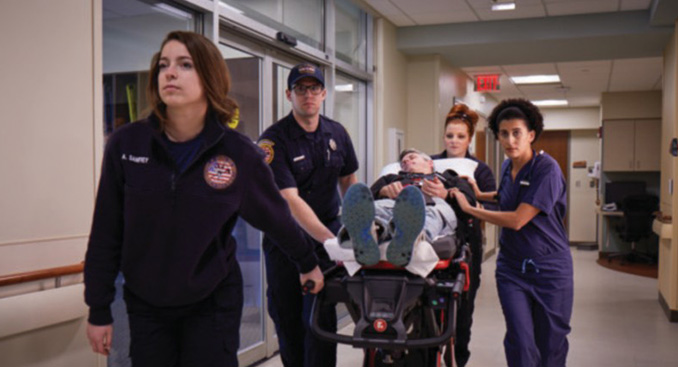- Community & News
- Heart
- Patient Stories
- Service Line
When Every Second Counts: Rapid, Lifesaving Care for Cardiovascular Emergencies

Patients count on TriHealth to deliver expert cardiovascular emergency care 24 hours a day, seven days a week for the full spectrum of concerns—from angina, aortic aneurysm and arrhythmia to heart attack, heart failure and stroke.
In cardiovascular emergencies, timing is everything, says Kenneth Patton, DO, Medical Director for TriHealth’s Bethesda North Hospital Emergency Department (ED). “If you’re having chest pain or shortness of breath, or signs of stroke, don’t wait. Call 911 and get to an Emergency Department as soon as possible.”
Fast Track for Heart Attacks
All TriHealth hospital EDs have protocols in place that fast-track cardiac patients. “Our goal is to obtain an electrocardiogram (EKG) within 10 minutes of a patient’s arrival,” says Dr. Patton. “The attending physician reviews the EKG and if a heart attack is confirmed, our STEMI team is alerted.” STEMI stands for ST-elevation myocardial infarction, a type of heart attack caused by a complete blockage in a coronary artery. Life-threatening, STEMI requires a quick response.
The STEMI alert at TriHealth mobilizes a team in the Cardiac Catheterization Lab to perform a balloon angioplasty, a non-surgical procedure that opens blocked coronary arteries. STEMI teams at Bethesda North Hospital and TriHealth’s Good Samaritan Hospital include an interventional cardiologist and an emergency medicine physician, nurses from cardiac catheterization and the ED, and staff from radiology, pharmacy and the laboratory.
Both Bethesda North and Good Samaritan hospitals have “door-to-balloon time” for heart attack patients averaging 50 to 60 minutes—significantly better than the national benchmark of 90 minutes. Door-to-balloon time is measured from when a heart attack patient enters the ED to the time the blocked artery is opened.
Heart attack patients stabilized at other TriHealth hospitals are transferred by ambulance or air transport to Bethesda North Hospital or Good Samaritan Hospital for catheterization.
Partnering With EMS
By partnering with Emergency Medical Services (EMS) in four Greater Cincinnati counties, TriHealth assures rapid treatment for heart attack patients throughout the region. Paramedics communicate with emergency department staff at Good Samaritan Hospital and Bethesda North Hospital via a modem that transmits EKG data directly from the ambulance to hospital personnel who activate the STEMI alert.
“The team is often ready and waiting for the patient in the Cath Lab before the ambulance even arrives,” says Dr. Patton.
Most TriHealth cardiac patients (about 99 percent) receive non-surgical emergency treatments such as angioplasty or pacemaker placement, another common ED procedure. When cardiac surgery is required, TriHealth transfers patients safely and quickly to the TriHealth Heart Institute at Bethesda North Hospital, where they’re met by a cardiothoracic surgeon.
Advanced Stroke Care
Like heart attack, every minute counts with stroke, a medical emergency caused when blood flow to the brain is stopped by a blood clot (ischemic stroke) or by a ruptured blood vessel (hemorrhagic stroke). “The quicker patients get to us, the quicker we can begin treatment, minimize damage to brain cells and improve outcomes,” says Dr. Patton.
All TriHealth EDs have trained stroke teams ready to evaluate patients and initiate care. Bethesda Arrow Springs, Bethesda Butler Hospital and Good Samaritan Western Ridge are accredited as Acute Stroke Ready EDs. Patients needing highly specialized treatment are stabilized at the closest ED and transferred to Good Samaritan Hospital or Bethesda North Hospital, both designated as Advanced Primary Stroke Centers.
Most ischemic strokes are treated with clot-dissolving medication. TriHealth meets national standards in “door-to-needle time,” which is measured from the time a patient enters the ED to the time clot- dissolving medication (called tissue plasminogen activator) is given.
A 2017 TriHealth initiative using a multidisciplinary approach for early recognition and treatment of stroke in the ED reduced door-to- needle times to an average of less than 60 minutes.
Pioneering New Treatments
Patients who have a blockage in one of the large arteries leading to the brain often don’t benefit from clot-dissolving medication.
Neurosurgeon Andrew Ringer, MD, Chief of TriHealth’s Neuroscience Institute, has pioneered a breakthrough option for these emergency stroke patients. Utilizing the Magellan Robotic Catheter System,
Dr. Ringer and his team perform a procedure called mechanical thrombectomy, a minimally invasive surgery in which a catheter is threaded through an artery to the clot. A tiny net-like device is inserted into the catheter and guided to the blockage, where it’s used to break up the clot and restore blood flow.
“This is one of the most advanced and latest and greatest techniques in stroke care,” says Dr. Patton. “It significantly decreases the time needed to remove large blood clots and restore blood flow to the brain.”
At every TriHealth emergency department, care is delivered by a dedicated team with decades of experience diagnosing and treating cardiovascular diseases and conditions. “Our nurses are certified in advanced cardiac life support and have specialty training in trauma and geriatrics,” says Dr. Patton. “Emergency medicine physicians are board-trained and our cardiologists are regional leaders in electrophysiology.”
Know the Symptoms
Though stroke and heart attack share a few symptoms, like dizziness and vomiting, most are different. Speed to treatment is critical for both of these medical emergencies, so it’s important to recognize them quickly. You could save a life. If you experience any of these symptoms, call 911.
Stroke:
- Sudden confusion and severe headache
- Face drooping
- Speech difficulty
- Arm weakness
- Numbness on one side of the body
- Sudden trouble walking
Heart Attack:
- Lightheadedness
- Shortness of breath
- Neck or jaw pain
- Chest discomfort
- Stomach cramps or nausea
Related Articles
- Community & News
- Heart
- Patient Stories
- Service Line